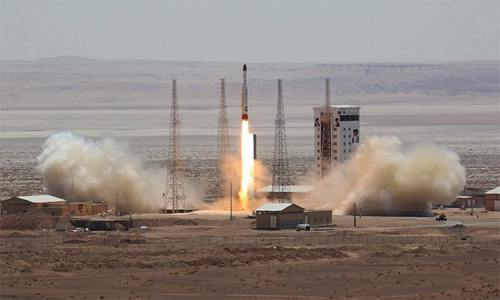Iran will launch the Zafar satellite, which collects images for scientific research and forecasting natural disasters in the country.
"The Zafar (Victory) weighs 113 kg and will be brought to the altitude of 530 km by Simorgh rocket in the next few days, flying around the Earth 15 times a day and will operate for over 18 months. Zafar will collect images. to study earthquakes, prevent natural disasters and develop agriculture, "Iranian Space Agency director Morteza Barari said during a press conference on February 1 in Tehran.

Iran tests Simorgh satellite (Sarfir-2) at Imam Khomeini Space Center in July 2017. Photo: Tasnim
Iran launched the first domestic satellite in orbit in 2009, the next two satellites were launched into space in 2011 and 2012. The rocket brought Nahid 1 communication satellite exploded due to technical problems at the Center. Imam Khomeini universe on 29/8, but Iranian Minister of Communications and Information Technology Mohammad Javad Azari-Jahromi posted an image on August 31 showing that the satellite was intact.
"80 scientists started producing Zafar satellites three years ago, this is Iran's latest step. We used to send one satellite to orbit 250 km from Earth. Iran supports peaceful exploitation." The space and all our operations here are transparent. The Iranian Space Agency hopes to build 5 more satellites by March 2021, "Barari said.
The US has asked Iran not to pursue a plan to launch satellites, accusing it of using rocket-like boosters and violating UN Security Council Resolution 2231. The resolution passed in 2015 endorsed an international agreement to curb Iran's nuclear program, urging it to restrict activities related to ballistic missiles capable of carrying nuclear weapons.
Iran has said it has no intention of developing nuclear weapons, saying its aerospace activities are peaceful and do not violate UN resolutions.
Tensions between the United States and Iran escalated after an air strike in Baghdad, Iraq on January 3, causing Maj. Gen Qassem Soleimani, commander of the Quds of the Iranian Revolutionary Guard (IRGC), and an Iraqi militia commander. network. Iran launched multiple missiles at US forces stationed at two bases in Iraq on January 8 in response, injuring 64 soldiers.
Hours after the missile strike, IRGC shot down a Boeing 737-800 bearing the number PS752 of Ukraine International Airlines (UIA), killing 176 people. Iran said the missile control officer mistook the Boeing as a "hostile target" because of its shape, altitude, and the aircraft suddenly turned toward a military base near Imam Khomeini International Airport in Tehran.



 JessicaTurnage
JessicaTurnage







